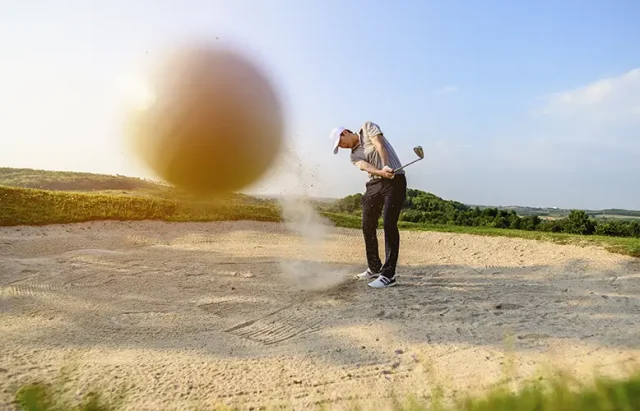
Roulette is the most frequent association we get when we think of a game of chance. Likewise, sports of precision and strategy like golf are always synonymous with skill. However, if big enough, an element of chance can lead to unpredictable twists, even in golf.
Sometimes, factors like a sudden gust of wind, an unexpected bounce, or the way a ball rolls on the green can dramatically affect the shot that a golfer has spent hours perfecting. Good golfers constantly account for these uncertainties before taking a shot, understand the role of chance, and know when to take risks.
In this article, we will discuss how different factors can influence golf shots, why golfers must apply different strategies when playing on special courses, the odds of risky shots, and whether they are worth it.
Variables Impacting a Golf Shot
Every person has a unique body with a different range of motions, strengths, and elasticity. It’s the same with golfers — each has its own playing style. Even so, players are well aware of the factors that can affect their swings and tirelessly work to counteract them.
The angle of the face of the club, the angle of the club head, the sweet spot (the area on the golf club’s face that must hit the ball), and the speed of the swing are all elements a golfer can master. But what about uneven terrain, temperature, air pressure, and humidity? No one can change these external factors.
Whatever the terrain, it will have witnessed its fair share of lucky and ill-fated events. Sometimes, an unruly tree branch can send your ball out of the course, while other times, it can be a water hazard with a noticeable impact on the shot.
Other unpredictable circumstances include gusts of wind, rainy weather, temperatures, and humidity. All these variables can easily send your scores plummeting or soaring.
Therefore, understanding and adapting to the terrain, weather, and the opponent’s play are fundamental parts of golf strategy. They require players to think critically about how each shot will be affected by these external conditions.
Different Courses Call For Special Strategies
Different golf locations require distinct strategies due to variations in course design, climate, terrain, and environmental challenges. Each course has unique features that demand specific approaches. Understanding and adapting to these variables is crucial to success on any golf course. Find out more about such strategies here.
Here are a few examples from famous golf courses and tactics golfers typically apply:
- Augusta National Golf Club (Georgia, USA) — Due to extensive elevation changes, strategically placed bunkers, and water hazards, players must prioritise precision, particularly in their approach to the greens.
- St Andrews Links (Scotland) — This golf course is known for its deep bunkers, wide fairways, coastal winds, and relatively flat terrain with large, undulating greens. Therefore, playing at St Andrews requires adaptability to the ever-changing wind conditions, which can significantly affect shot distance and direction.
- Pebble Beach Golf Links (California, USA) — Pebble Beach has a hilly terrain with numerous cliffs and water hazards, accompanied by frequent ocean breezes. Thus, accuracy is crucial — golfers must account for the wind and aim for a careful shot, particularly on holes like the par-3 7th.
Risky Golf Shots Odds
Risky golf shots, such as an albatross, double eagle on par-5, or a birdie on a challenging hole, carry significant odds and often involve a blend of skill, strategy, and a fair amount of luck. These shots require precise execution and thorough course knowledge. That said, even the best golfers know that factors like wind, terrain, and other unforeseen variables can tip the scales.
For example, the odds of achieving an albatross (three under par on a hole) in golf are extremely rare, about 1:6 million, meaning that luck plays a significant role. This shot requires a perfect drive, an accurate second shot, and ideal conditions, elements even professional golfers rarely align.
In contrast, the odds of making a birdie (one under par) are more common, around 1:20 for the average golfer, though this varies with skill and hole difficulty. While expertise is key in making a birdie, luck still plays a part, such as a fortunate bounce or a favourable angle on the green.
When comparing these odds to those of online casino slots, like those available on the Mega Casino Slots UK site, it becomes apparent that the biggest difference is reflected in the balance between skill and luck. While golfers can impact their odds through practice and decision-making, slot players need to rely on chance, considering algorithms and fixed probabilities determine the outcomes.
Although both involve an element of risk and the thrill of uncertainty, the odds in golf are more dynamic and can be improved with experience. In contrast, slot odds are fixed, offering a more predictable yet entirely luck-based gaming experience.
Conclusion
Luck plays a vital role in golf, rendering even the best-planned shots unpredictable. While skilled golfers rely on strategy, carefully planning their shots and adjusting for course conditions, unforeseen elements like wind, terrain, and tricky pin placements can still impact the game’s outcome. Therefore, we can safely say winning at golf is a blend of strategic thinking and acceptance of the unpredictable.





